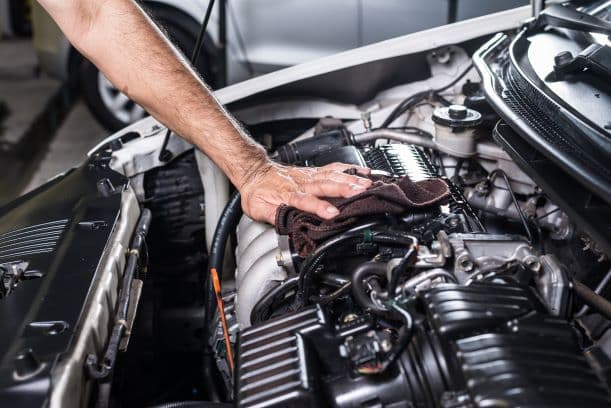Most people never bother to detail their vehicle’s engine. Why would they? No one ever sees the engine and its always so filthy. But when you consider the advantages of engine detailing, including a better-running, longer-lasting engine, and higher resale value, it can make a big difference
7 STEPS TO DETAIL A VEHICLE’S ENGINE
Cleaning your engine starts with getting all your cleaning products and tools together. A good engine detailing kit will contain the following:
- Non-petroleum based engine degreaser, engine cleaner, CLR cleaner, engine protectant, and rubber and vinyl protectant
- Plastic bags and microfiber towels
- Cleaning brush and toothbrush
- Compressed air
- Pressure washer or other pressurized water
With your cleaning kit nearby, you’re ready to have the engine of your car detailed.
- Warm the Car Engine – It will help to get off grease and dirt if the engine is warm to the touch. Before you begin the actual detailing, start the engine and let it run for a few minutes before shutting it off.
- Wrap Sensitive Areas – Not every [part of the engine likes getting wet. Use the plastic bags to cover the distributor, spark plug openings and any electrical connectors that may be exposed to moisture.
- Remove Excess Debris from the Engine Compartment – You engine bay can become home to all sorts of leaves, pine needles and other debris that collects is every nook and cranny. You can get into the deep auto detailing without getting rid of the debris first.
- Degrease the Engine – Petroleum based degreasers can cause plastic and rubber parts to deteriorate over time. Degrease from lower parts to the top to avoid getting degreaser on you. For stubborn spots, use the engine cleaner or car wash solution. You can apply them with the brush if needed. Use the toothbrush for hard to reach places. Be careful not to get degreaser on exterior painted surfaces of your vehicle. It will strip protective layers of wax, which could result in premature paint fading and a visit to an auto body shop.
- Spray the Engine – After degreasing, use the high-pressure washer to wash it away with a steady stream of water. Avoid directly spraying electrical connections and the areas you have wrapped in plastic.
- Dry the Engine – You can let the engine air dry. Use the microfiber cloths to wipe any accessible areas and parts.
- Add Protectant – Once the engine is dry, apply engine protect to the entire engine, except for the rubber and vinyl parts, where you’ll use rubber and vinyl protect. Wipe off any extra protectant with a clean microfiber cloth.
If you enjoyed this post, check out our recent article on the seven steps of how to fix rust on a car.

